Pasadena City Hall
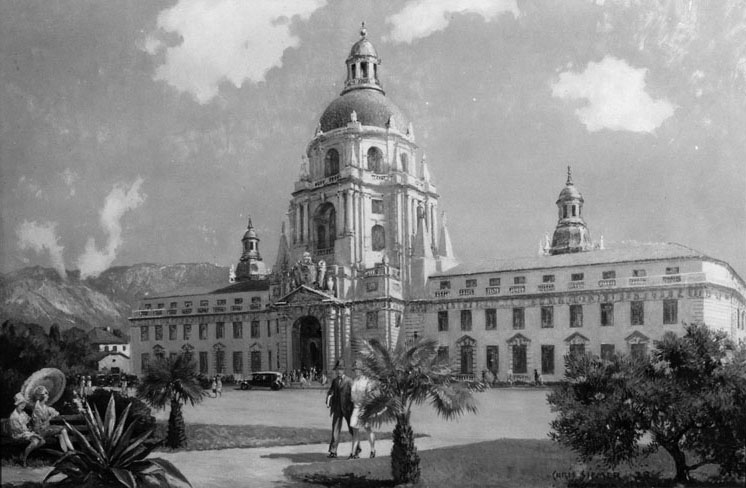 |
|
| (1927)* - Rendering showing Pasadena City Hall as it appeared shortly after it opened. Painting by Chris Siemer |
Historical Notes In 1923, the people of Pasadena approved a bond measure issuing $3.5 million towards the development of a civic center. City Hall was to be the central element of this center. The San Francisco architecture firm of Bakewell and Brown designed City Hall, which has elements of both Mediterranean Revival Style and Spanish Colonial Revival Style architecture.^ |
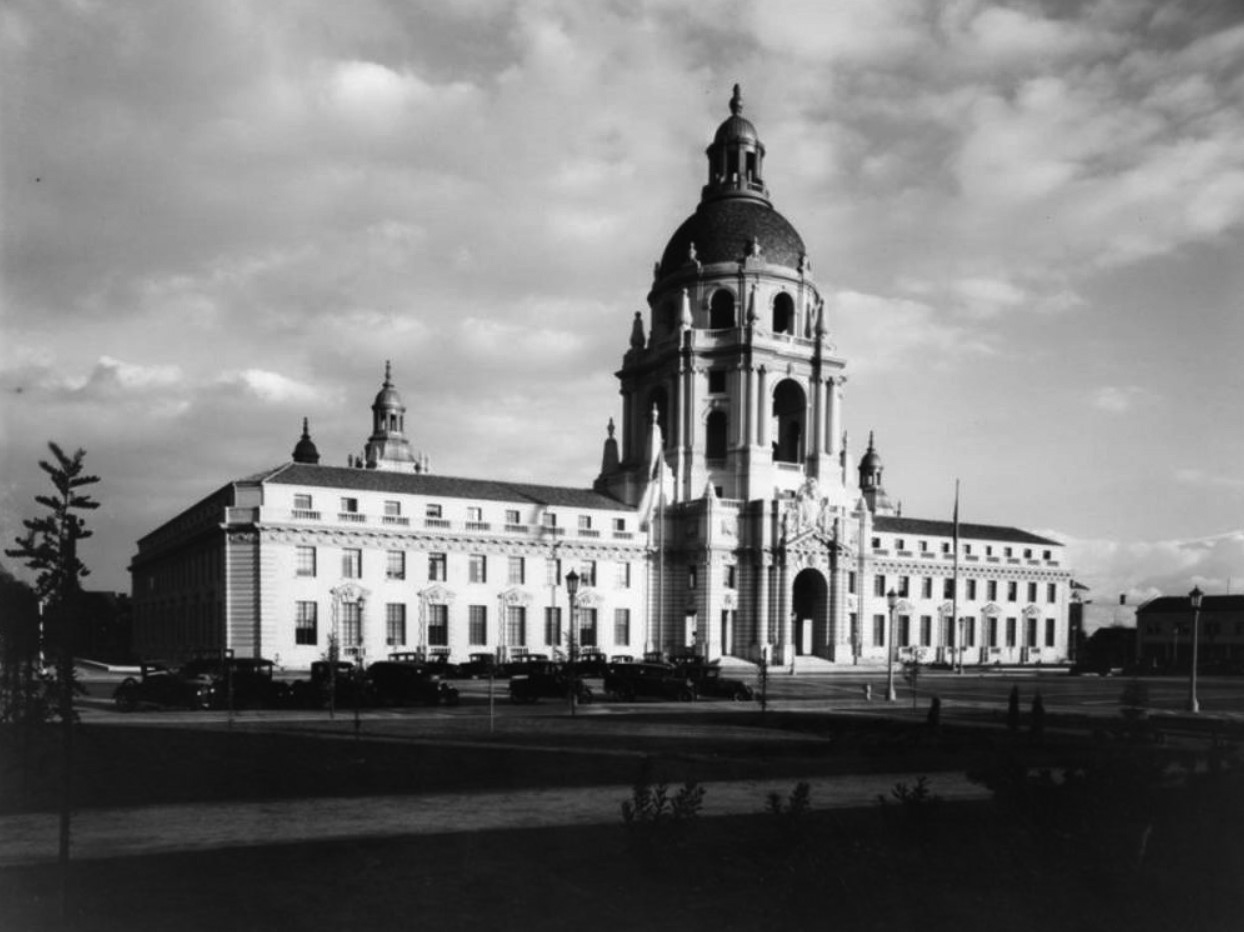 |
|
| (1930)* – View showing Pasadena's City Hall before it was surrounded by buildings. Note the architectural designs on the tower. Date built: 1925-27. Architects: Bakewell & Brown. Photo dated: January 17, 1929. |
Historical Notes Completed on December 27, 1927, the massive circular structure rises perpendicularly for six stories. The fifth story is 41 feet high and pierced with four huge round arches and four smaller ones. The next story, set back a little, is 30 feet high and is also pierced with arches. Above it rises the dome 26 feet high and 54 feet across. On top of the dome is the lantern, a column-supported cupola 41 feet high, surmounted by an urn and ball. The highest point is 206 feet above the ground.* |
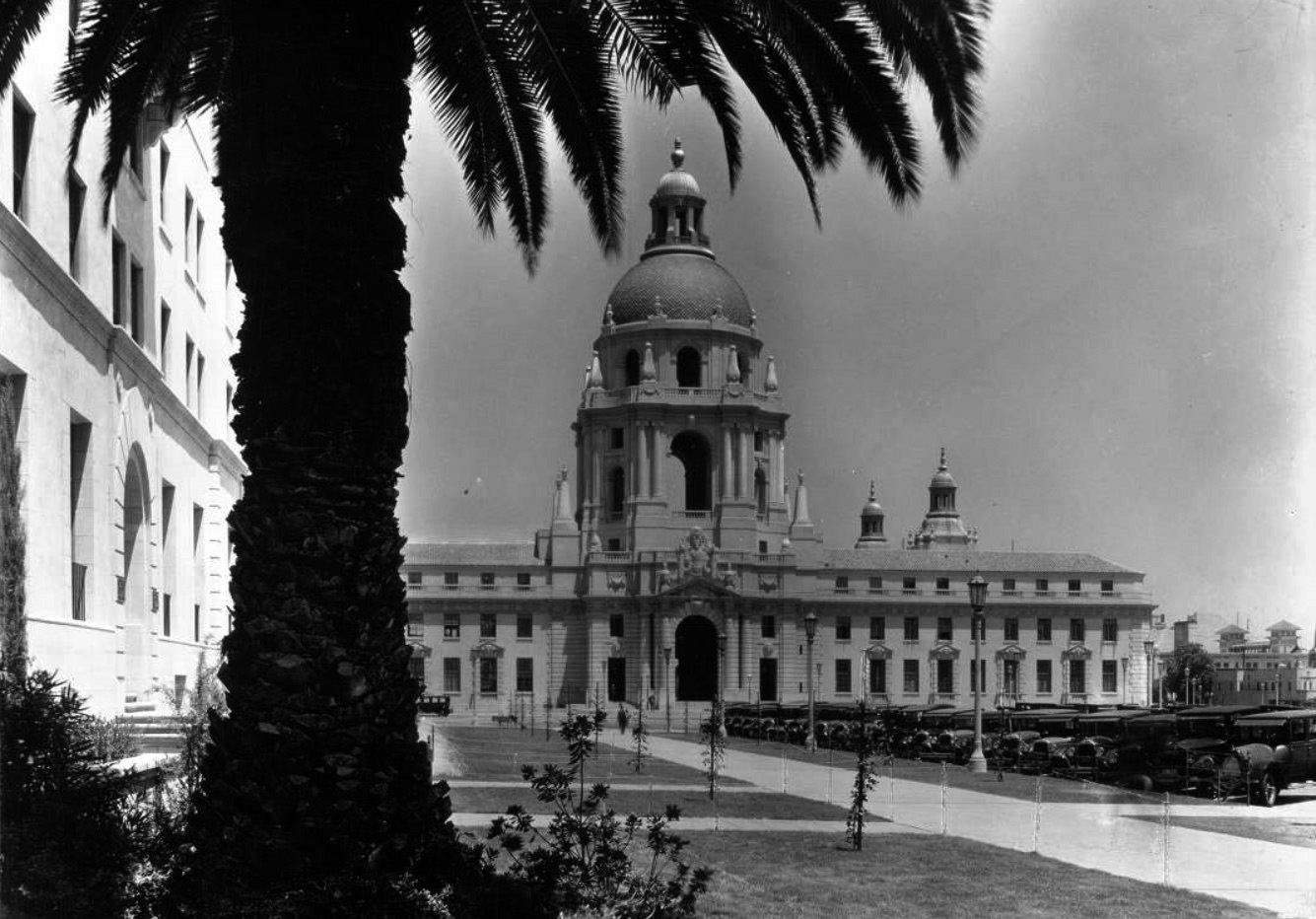 |
|
| (ca 1930)* - Not a parking space to be had in front of City Hall. |
Historical Notes For the final design, the San Francisco architectural firm of Bakewell and Brown turned to the style of 16th century Italian architect Andrea Palladio, who had studied and admired the Roman architect Vitruvius, as did the California mission-building padres. Palladio represented the simple, serene, classical style of the early Renaissance, in contrast to the Gothic style of medieval times and the rococo style of the later Renaissance. Three famous European domed structures show Palladio’s influence: the church of Santa Maria della Salute in Venice, the Hotel des Invalides in Paris and St. Paul’s Cathedral in London. Without being a direct imitation, Pasadena City Hall is related to them all.* |
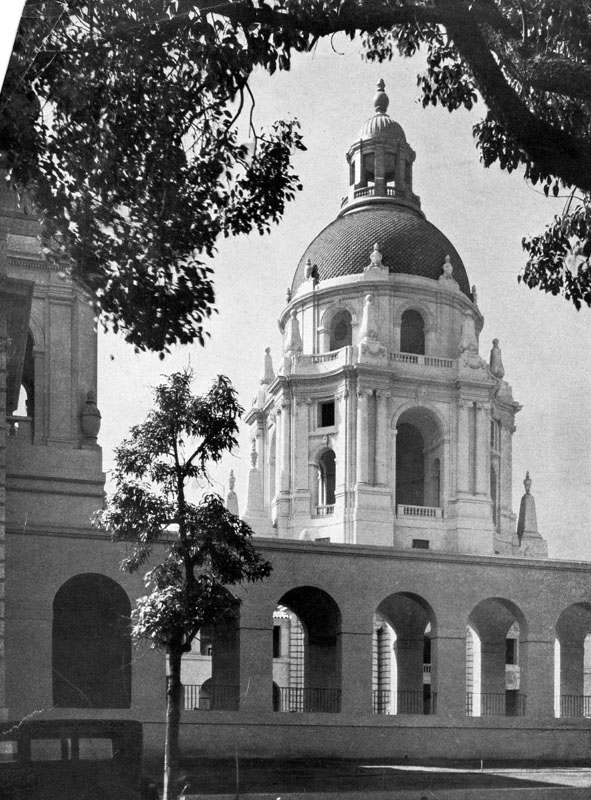 |
|
| (1928)* - Close-up view of the west facade showing the rotunda at Pasadena's City Hall, 100 North Garfield Avenue. |
Historical Notes The massive circular tower structure rises perpendicularly for six stories. The fifth story is 41 feet high and pierced with four huge, round arches and four smaller ones. The next story, set back a little, is 30 feet high and is also pierced with arches. Above rises the dome, 26 feet high and 54 feet across. On top of the dome is the lantern, a column-supported cupola 41 feet high, surmounted by an urn and ball. The highest point is 206 feet above the ground.* |
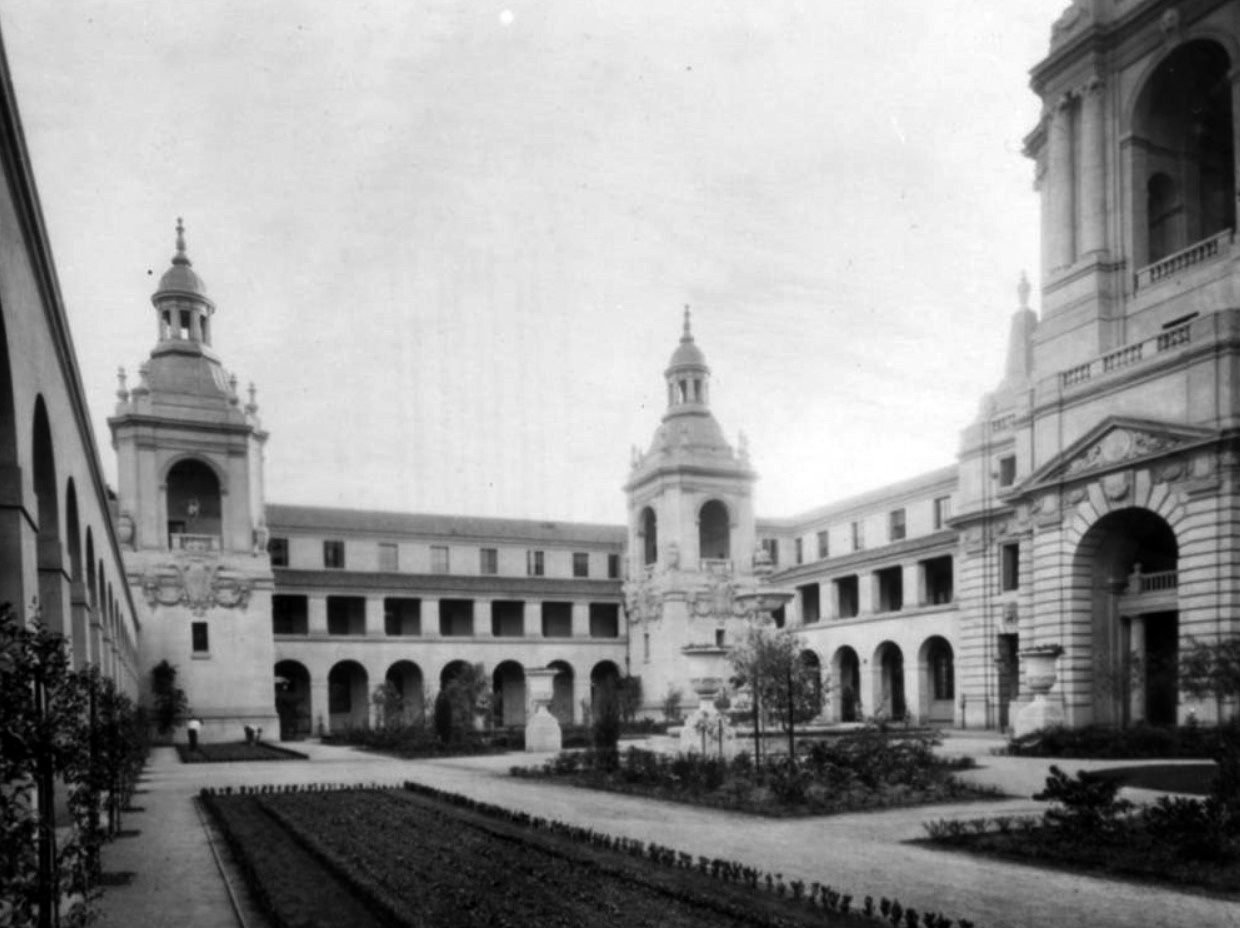 |
|
| (1930s)* - Overall view of the courtyard at Pasadena City Hall. Note the architectural designs on the two towers and the building. Architects: Bakewell & Brown. |
Historical Notes Pasadena City Hall has long been a favorite shooting location for filmmakers. The courtyard was used in the 1995 movie "A Walk in the Clouds" to portray a Napa Valley town square. It has also been used as an embassy in the "Mission: Impossible" television series, and a villa in Charlie Chaplin's Oscar-nominated 1940 film "The Great Dictator."^ |
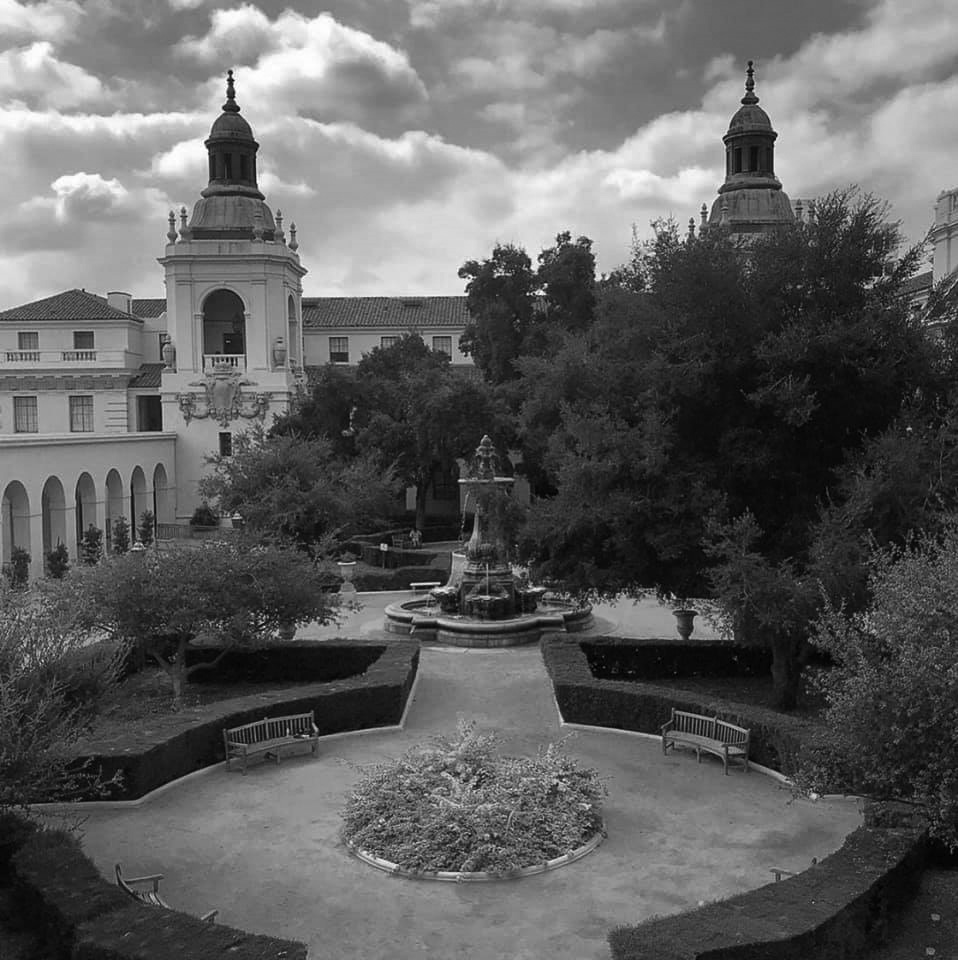 |
|
| (2020)^.^ - Pasadena City Hall courtyard. Photo courtesy Sonia Morin |
Historical Notes The courtyard has a strong Spanish Colonial atmosphere. The focal point is the cast stone Baroque fountain. 22.5 feet tall with a basin 25 feet in diameter. Paths of crushed granite define the flower beds and cloistered arches paved with red Padre tile surround the courtyard. California live oak trees provide shade for the azaleas, hydrangeas, rhododendron and beds of annuals that are planted on a rotational basis.* |
 |
|
| (1930)* - Scenic view of Pasadena City Hall and its surrounding area, with mountains in the background. Building on left of photo (past the tall pine tree) is the Y.W.C.A., located on the southeast corner of Marengo Avenue and Holly Street. It is a 3 story, plain, boxy building with long horizontal windows. Date built: 1920-1922. Designed by Julian Morgan in Mediterranean style. |
Historical Notes The way had been prepared in 1923, when the people of Pasadena passed a bond issue of $3.5 million to establish a civic center. The Chicago firm of Bennett, Parsons and Frost was commissioned to draw up a civic center plan. The planners established Garfield Avenue as an axis, on which City Hall was to be the central element, with the Pasadena Public Library to the north and the Pasadena Civic Auditorium to the south. Also included in the original design were the Pasadena Police Department, Pasadena Municipal Court, YMCA, YWCA, Southern California Gas Company and United States Post Office. Over the years the new police building and county court house have been added. The YMCA building is now Centennial Place, a single-room-occupancy residential complex, and the Southern California Gas Company building now serves as the city's Permit Center. The YWCA building is unoccupied because of seismic and other issues.^ |
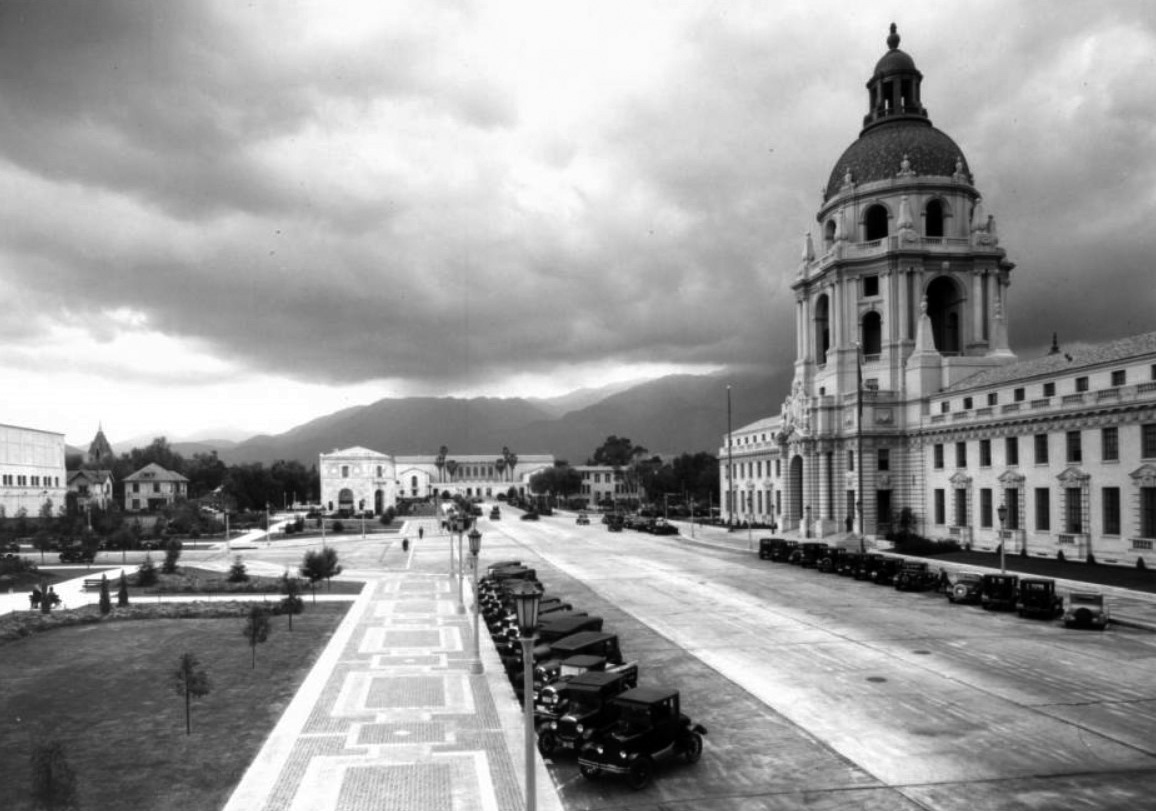 |
|
| (ca. 1936)^ - The Pasadena City Hall seen along with other buildings on the Civic Center. Photo by Dick Whittington |
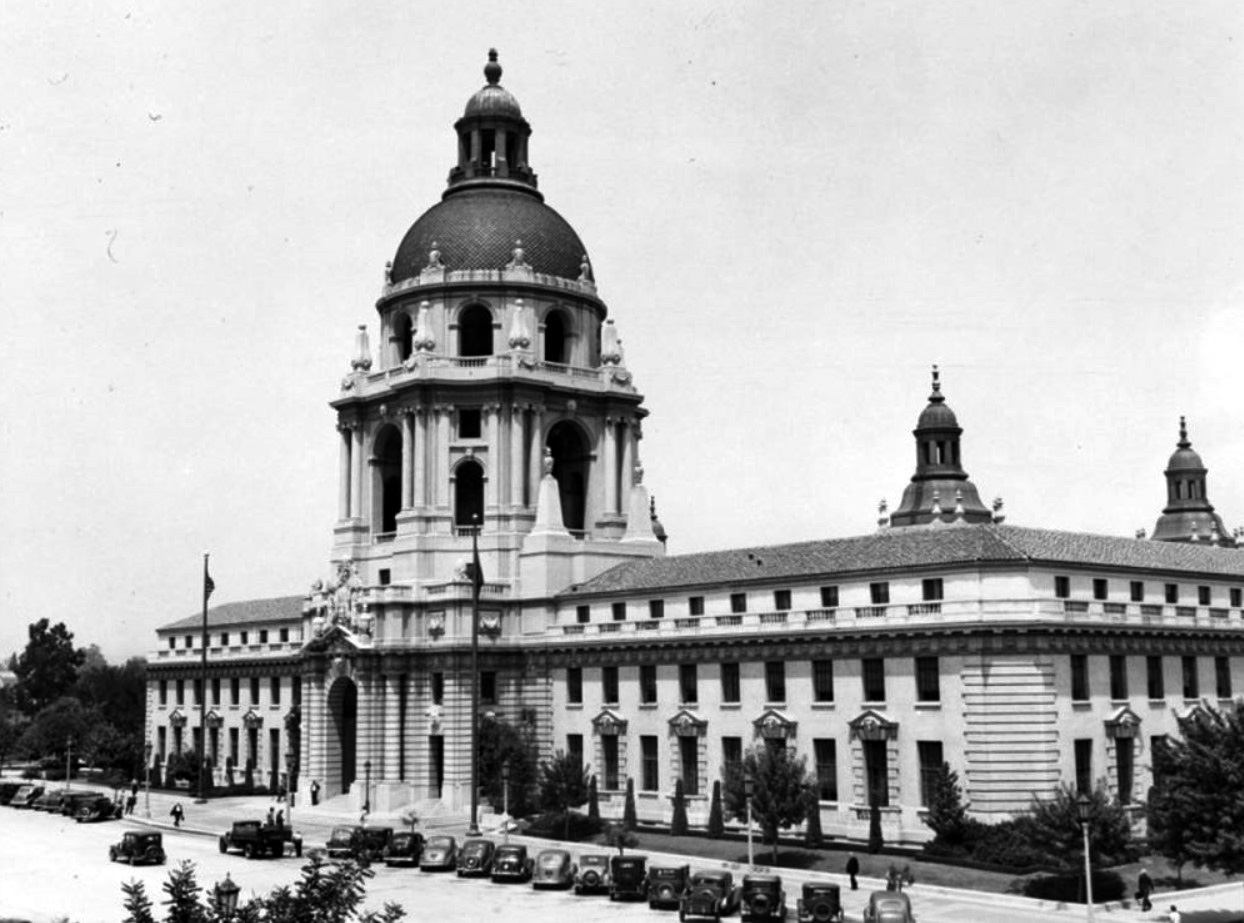 |
|
| (1937)* - Exterior view of Pasadena City Hall at 100 North Garfield Avenue, in Pasadena. Note the architectural designs on the rotunda and building. |
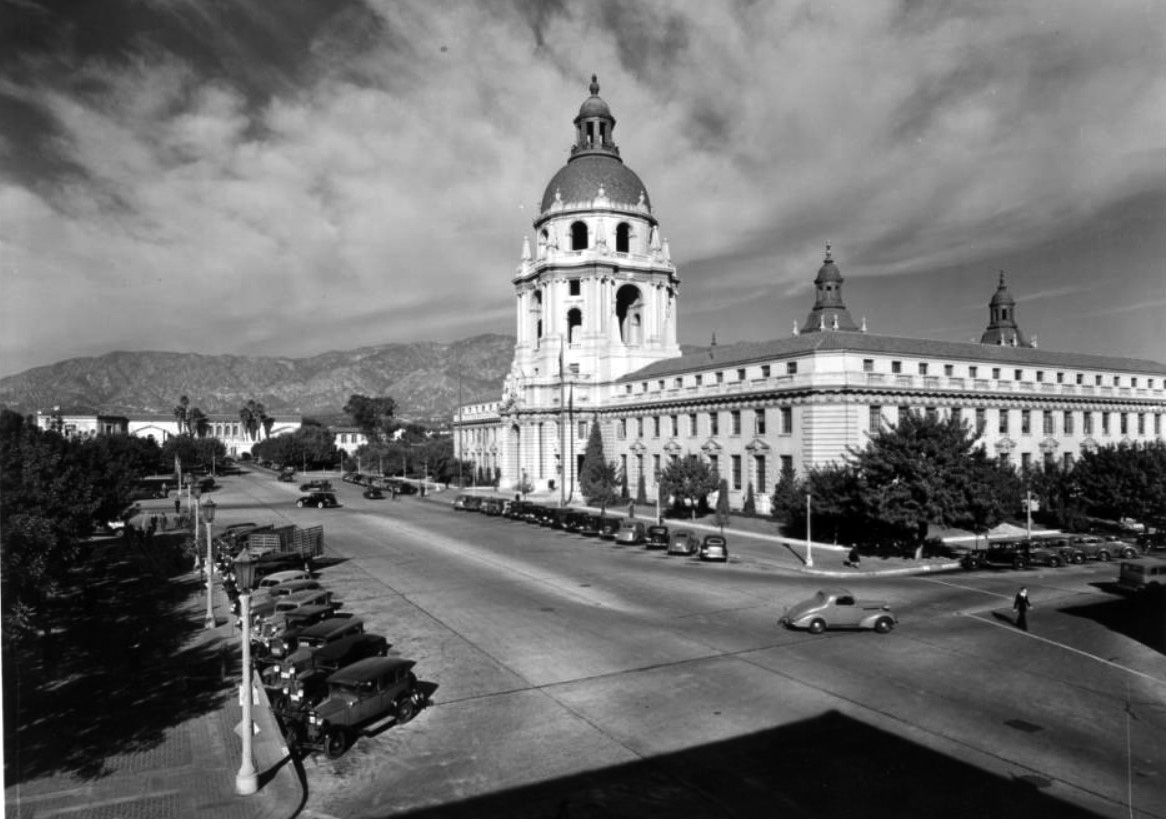 |
|
| (ca. 1938)^ - A corner view of the Pasadena City Hall with the mountains in the background. Photo by Dick Whittington |
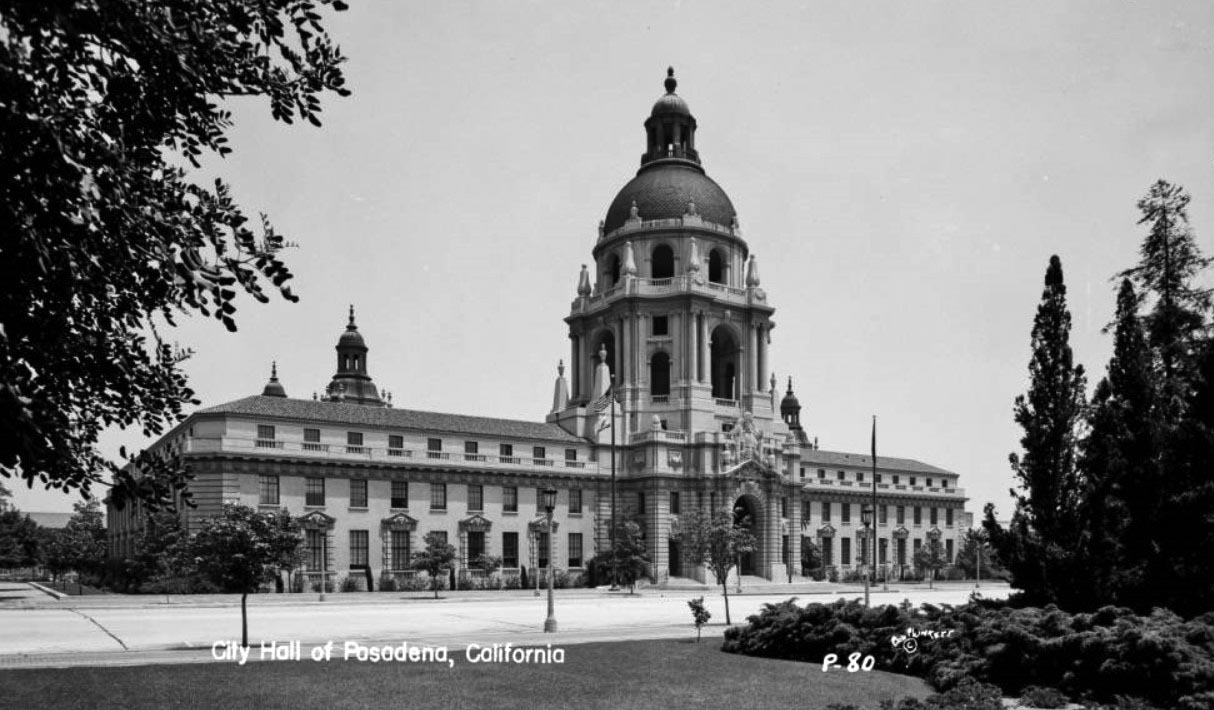 |
|
| (ca. 1948)#* – Postcard view showing the Pasadena City Hall building and lawn as seen from across Garfield Street. |
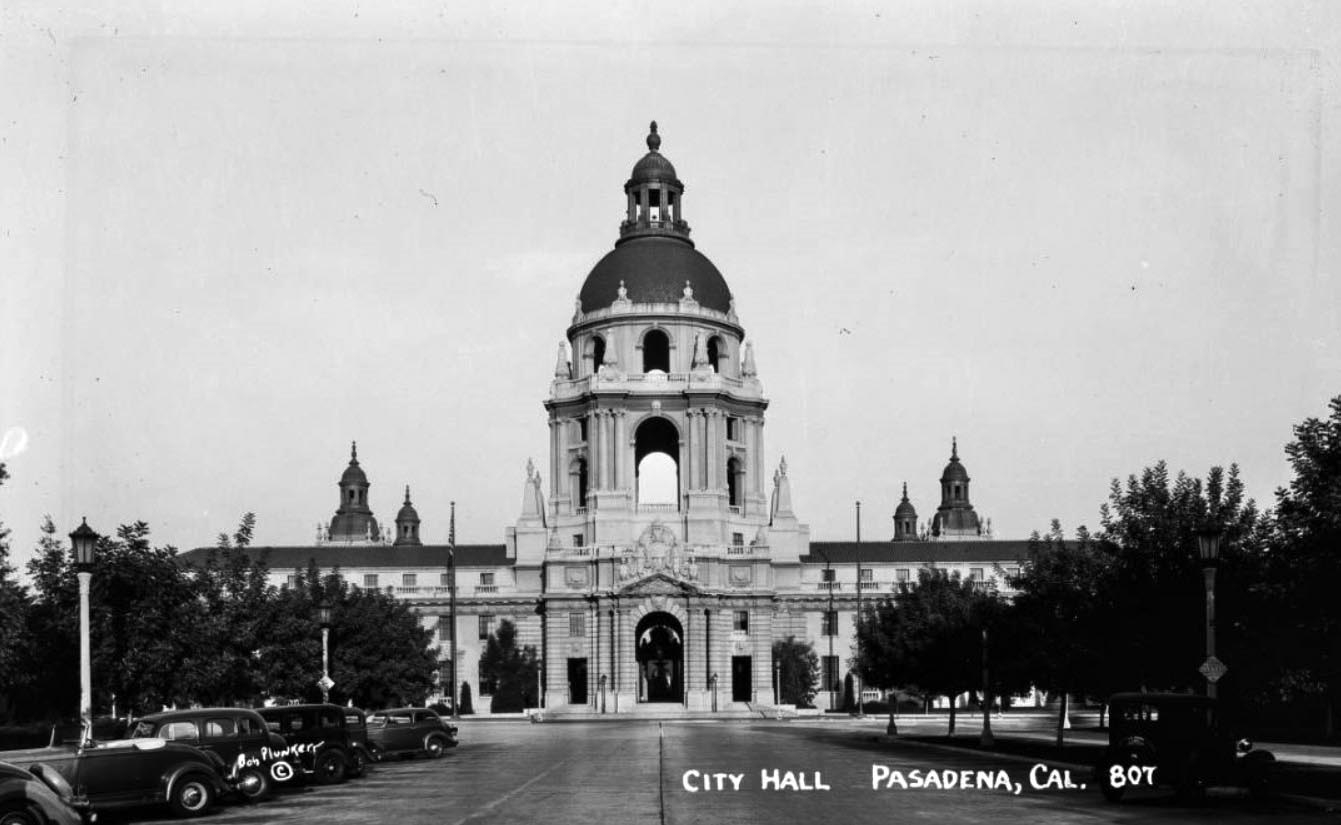 |
|
| (1940s)#* - Postcard view of Pasadena City Hall as seen looking down East Holly Street, with automobiles parked at the curb. |
Historical Notes City Hall is an internationally recognized star of stage and screen, appearing in Chaplin’s “The Great Dictator” in 1940, and many, many films, television shows, and wedding albums since. |
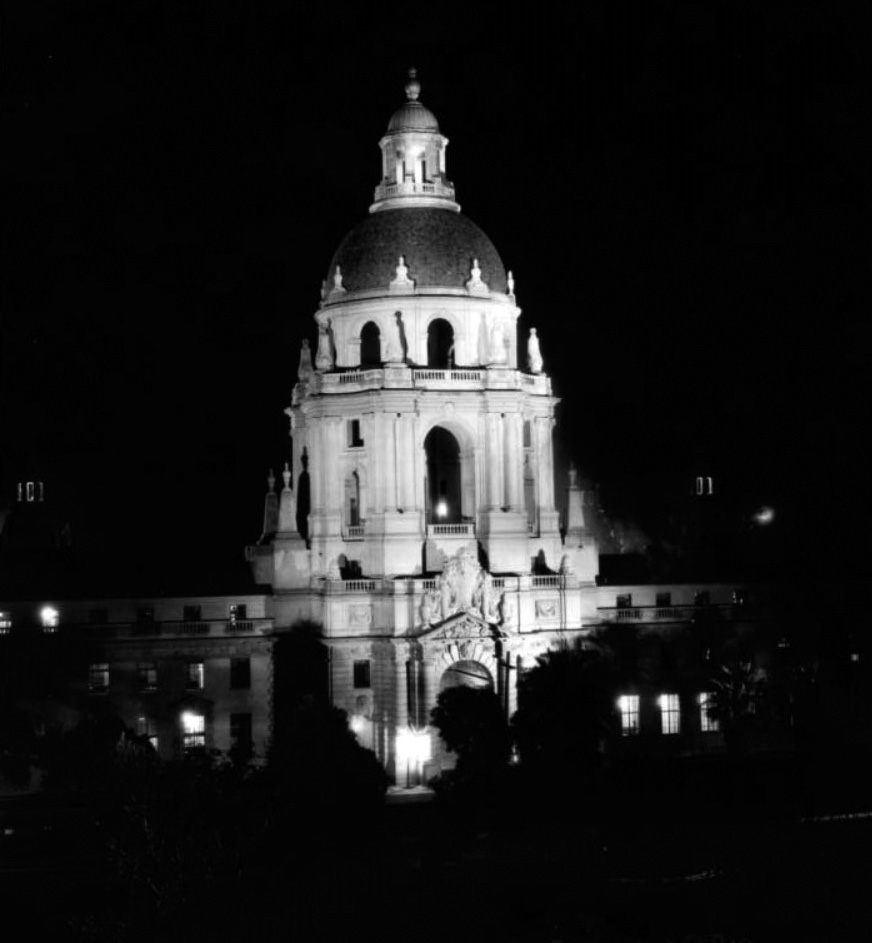 |
|
| (ca.1928)^ – Nightime view showing the large, lightly-colored City Hall building with a dome at the top of its center tower. A statue stands over the large doorway. The bright interior lights shine through the windows to the trees of the yard in the foreground. |
Historical Notes Pasadena City Hall served as the city hall of fictional Pawnee, Indiana, in the television show "Parks and Recreation." The dome is visible through the window of the main characters' apartment building in the television show The Big Bang Theory.^ |
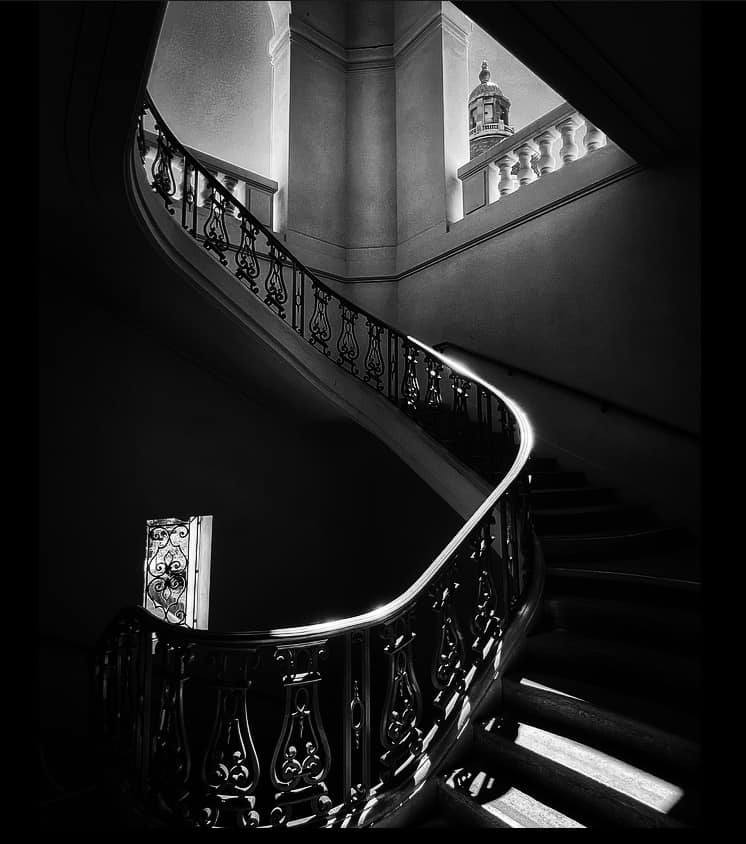 |
|
| (2022)* – Climbing up the staircase at Pasadena City Hall. Photo courtesy of Carlos G. Lucero |
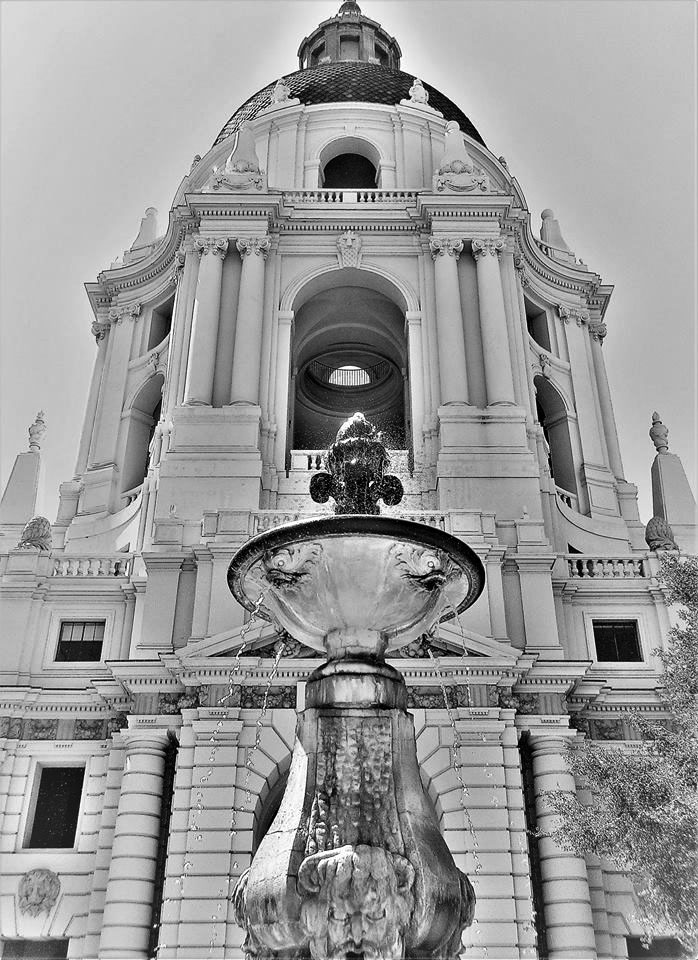 |
|
| (2019)^.^ - Looking up toward the top of Pasadena City Hall. Photo courtesy of Howard Gray |
Historical Notes On July 28, 1980 the Civic Center District, including Pasadena City Hall, was listed on the National Register of Historic Places. |
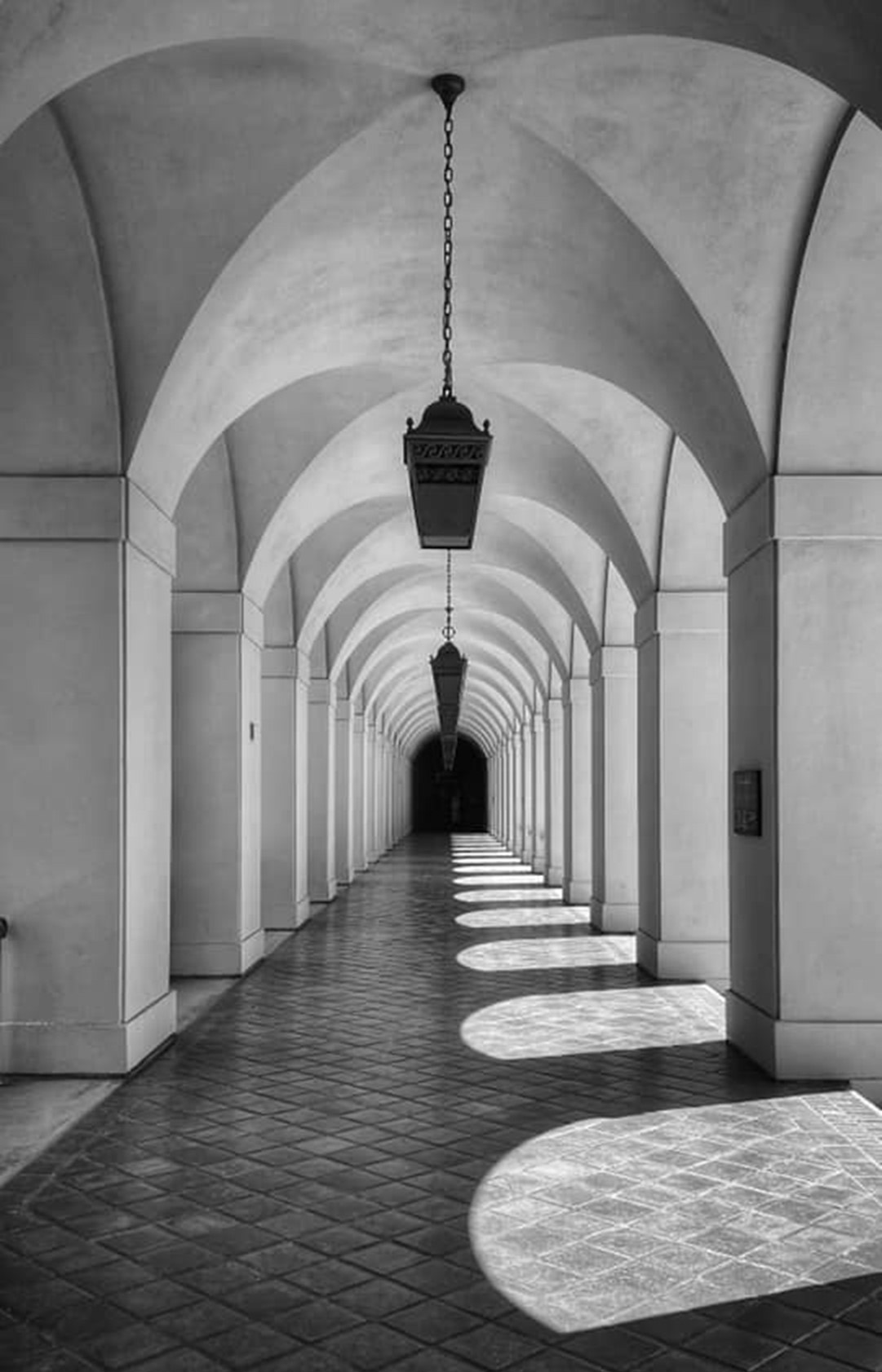 |
|
| (2021)* - Pasadena City Hall corridor. Photo by Carlos G. Lucero |
Historical Notes The building recently underwent a massive rehabilitation project, including a sophisticated base isolation seismic retrofit. City Hall will now continue to be the centerpiece of Pasadena’s Civic Center, one of the most complete manifestations of City Beautiful architecture and urban planning in the United States.* |
Then and Now
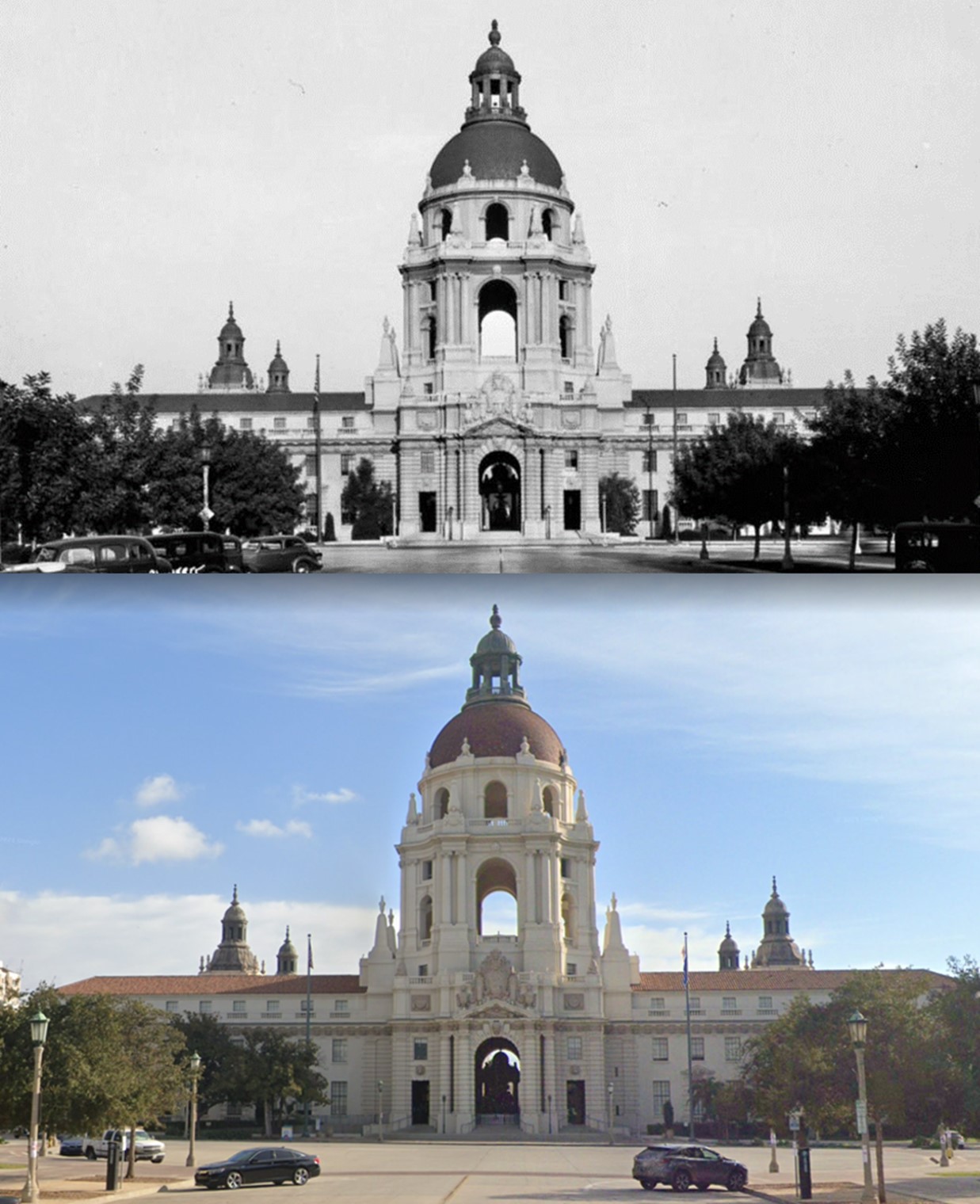 |
|
| (1940s vs. 2021)* - Designed by Architects: Bakewell & Brown, the 1927-built Pasadena City Hall is the favorite historic building in Pasadena based on recent polls. |
Historical Notes The City Hall has long been a favorite shooting location for filmmakers. The courtyard was used in the 1995 movie "A Walk in the Clouds" to portray a Napa Valley town square. The building is in also featured in the 2005 film “Rumor Has It” directed by Rob Reiner. It has also been used as an embassy in the "Mission: Impossible" television series, and a villa in Charlie Chaplin's Oscar-nominated 1940 film "The Great Dictator." The building also served as the city hall of fictional Pawnee, Indiana, in the television show Parks and Recreation. The dome is visible through the window of the main characters' apartment building in the television show The Big Bang Theory, set in Pasadena. The building featured in the last episode of Jericho; it was used as the City Hall of Cheyenne, Wyoming.^ In a poll conducted in 2004 by Pasadena Heritage, a local, non-profit preservation organization, Pasadena City Hall was identified by both visitors and residents alike at their “…favorite historic building in Pasadena.” |
* * * * * |
|
Other Sections of Interest |
|
Water and Power in Early LA |
|
Newest Additions |
New Search Index |

A new SEARCH INDEX has been added to help navigate through the thousands of topics and images found in our collection. Try it out for a test run.
Click HERE for Search Index |
* * * * * |
< Back
Menu
- Home
- Mission
- Museum
- Major Efforts
- Recent Newsletters
- Historical Op Ed Pieces
- Board Officers and Directors
- Mulholland/McCarthy Service Awards
- Positions on Owens Valley and the City of Los Angeles Issues
- Legislative Positions on
Water Issues
- Legislative Positions on
Energy Issues
- Membership
- Contact Us
- Search Index
© Copyright Water and Power Associates
Layout by Rocket Website Templates